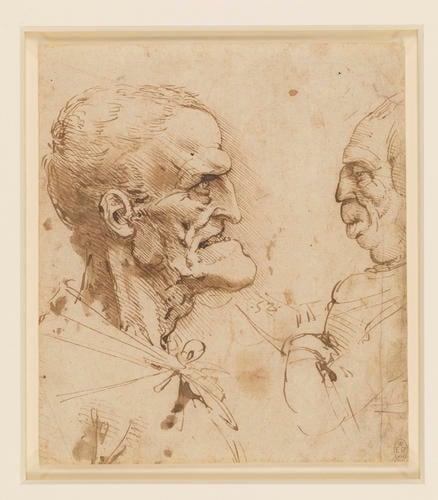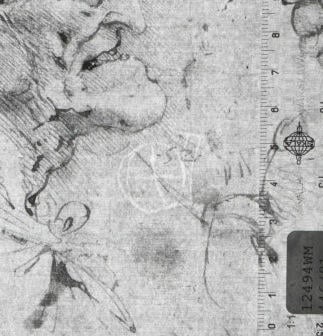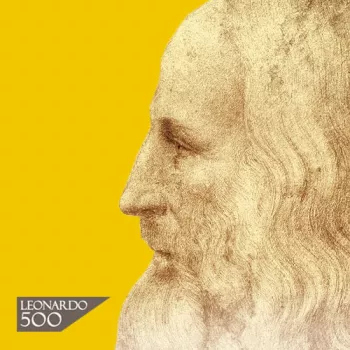Two grotesque profiles c.1485-90
Pen and ink, wash | 16.3 x 14.3 cm (sheet of paper) | RCIN 912490
-
A drawing of the head and shoulders of an elderly man in profile to the right, with an enormous jutting chin. Facing him is an old creature on a smaller scale, intended to be female, with a very long upper lip and a double chin. Melzi's number 52.
Around 1490 Leonardo studied human proportion, attempting to find the mathematical basis of ideal beauty. But by deliberately distorting these proportions, he could also create images of ‘ideal ugliness’. This is one of the finest examples of Leonardo's fierce old men, the vigorous strokes of the pen blocking out his spare and deeply lined features with a strongly exaggerated brow and chin. Unusually among the grotesques, the profile was finished with areas of wash. Facing him is the hideously fleshy profile of an old woman, her hair drawn back and her left arm tucked under a bosom trussed so tightly that her breasts bulge out above the bodice. She is the embodiment of aged vanity.A contrast between bony and fleshy types was surely intended by Leonardo. The juxtaposition of two contrary motifs (of any kind) to explore and magnify each one was a standard rhetorical device, known in Greek as antithesis and in Latin as contrapositum. The Italian term, contrapposto, is now applied exclusively to the visual arts, to describe the method of posing a body so that the parts are in balanced opposition to one another; but in the Renaissance it could still be applied to the more general requirement to formulate a composition with many different elements in lively counterpoint - the insistence on variety found in all treatises on the arts.
The difference in scale between the two figures indicates that Leonardo did not initially conceive of them as interacting, and that the gesture of the old woman, holding her hand to the chin of the man in a romantic gesture, was an afterthought. But by uniting the two figures in this manner Leonardo turned them into a pair of ridiculous aged lovers (a subject treated again in 912449), and thus a parody of the opposed profiles of married couples that (in diptych form) was one of the standard modes of fifteenth century portraiture. Here a fierce old man faces a vain old woman, her hair pulled back and bodice tightly laced, holding her hand to the man’s chin in a romantic gesture. Leonardo thereby turns them into a pair of aged lovers, a parody of the paired profiles of married couples that were common in fifteenth-century portraiture.
Text adapted from M. Clayton, Leonardo da Vinci: The Divine and the Grotesque, London 2002Provenance
Bequeathed to Francesco Melzi; from whose heirs purchased by Pompeo Leoni, c.1582-90; Thomas Howard, 14th Earl of Arundel, by 1630; probably acquired by Charles II; Royal Collection by 1690
-
Creator(s)
Acquirer(s)
-
Medium and techniques
Pen and ink, wash
Measurements
16.3 x 14.3 cm (sheet of paper)
Object type(s)












